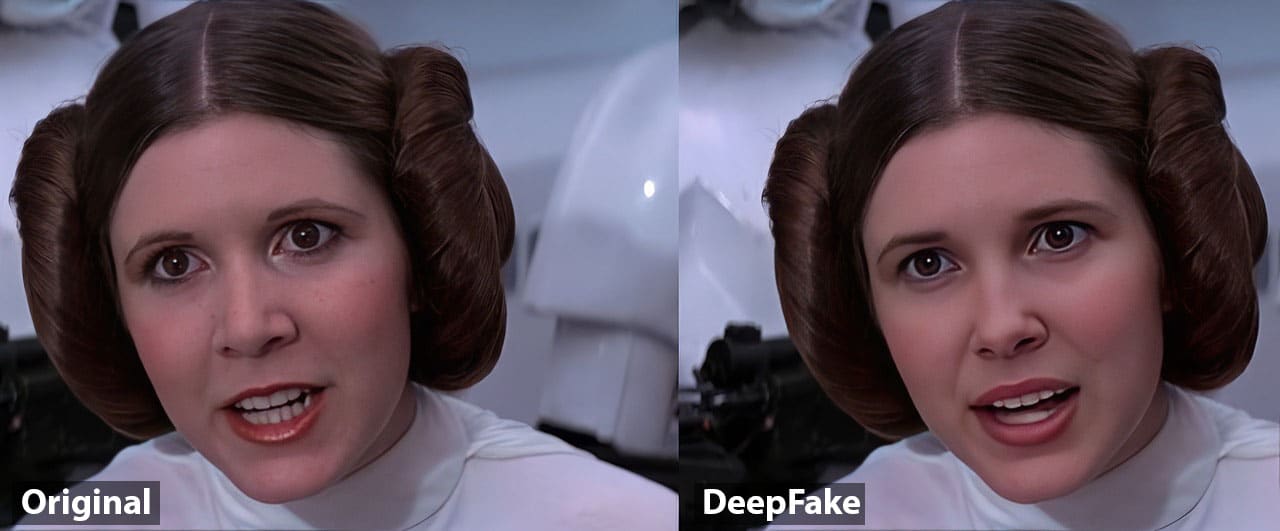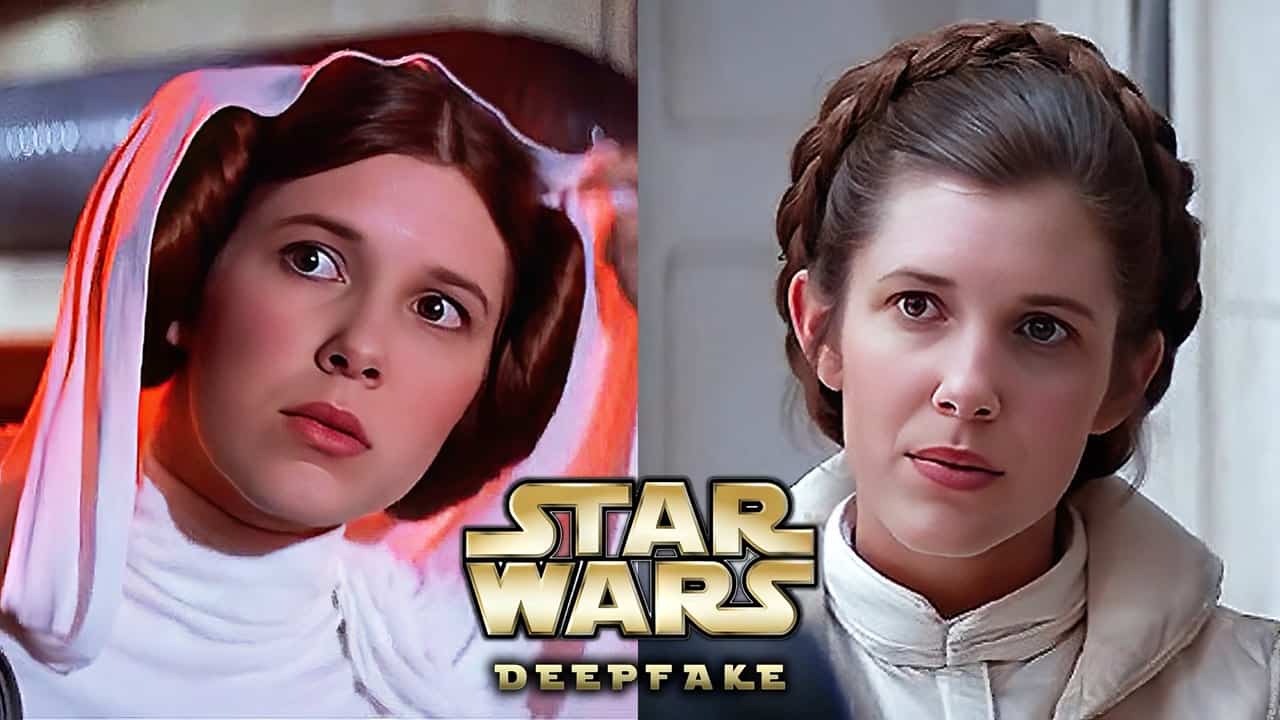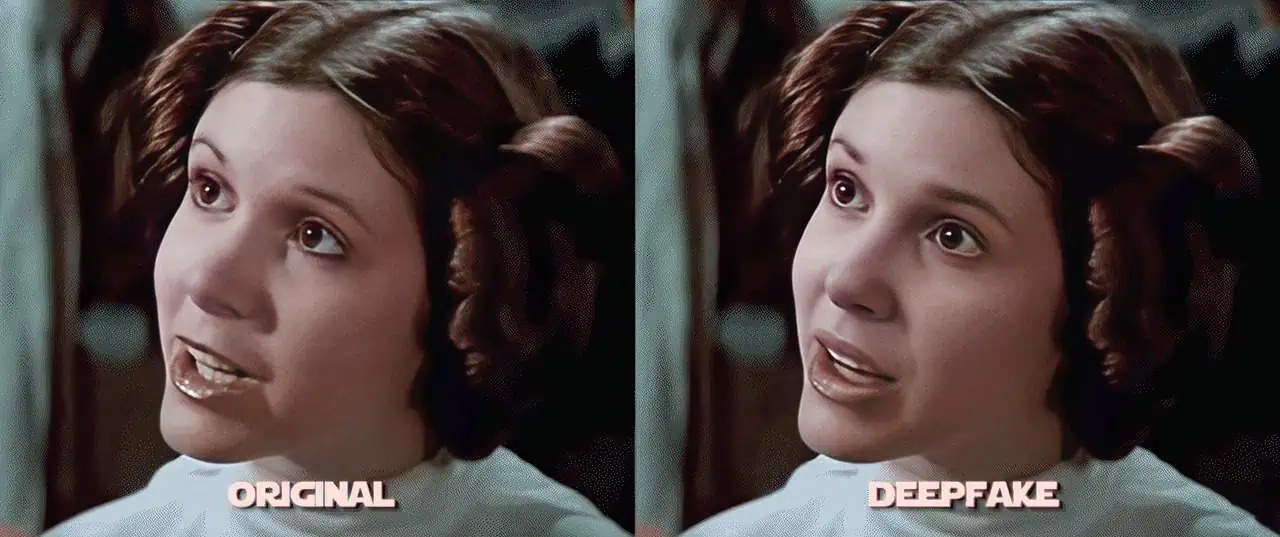Imagine a world where beloved characters from different realms of pop culture can merge, creating an entirely new and captivating experience for fans. This is precisely what happened when Millie Bobby Brown, the talented star of Stranger Things, was DeepFake’d into none other than the iconic Princess Leia from Star Wars.
In this blog post, we’ll dive deep into the magic behind this mesmerizing transformation and explore its potential impact on Hollywood’s future.
Key Takeaways
Deepfake technology can superimpose one person’s face onto another’s body using AI algorithms, which raises ethical concerns about identity theft and misinformation.
Millie Bobby Brown was DeepFake’d as Princess Leia in a viral video that showcased her similarity to the late Carrie Fisher, who portrayed the iconic Star Wars character.
Despite potential negative consequences, there are benefits to using DeepFake technology in entertainment, including keeping beloved characters alive and broadening casting options.
Table of Contents
Who Is Millie Bobby Brown?
Millie Bobby Brown, a talented young actress, gained widespread recognition for her breakout role as Eleven in the hit Netflix series “Stranger Things.” Since then, she has displayed her diverse acting abilities in various projects such as “Godzilla: King of the Monsters,” where she starred as Madison Russell and charmed audiences with a captivating portrayal of Enola Holmes in the 2020 Netflix film.
Not only is Brown known for her acting skills but also as an accomplished SEO expert and high-end copywriter. Her success extends beyond Hollywood; it’s no wonder fans are always anticipating what this versatile artist will do next.
Princess Leia: A Brief Overview
Millie Bobby Brown, known for her breakout role in Stranger Things, has been the subject of a stunning deepfake video that showcases her as Princess Leia. This viral sensation is yet another example of the rise of AI-generated content and its potential implications for entertainment. Princess Leia, played by the late Carrie Fisher, remains one of Star Wars’ most iconic characters. Her impact extends beyond just the franchise itself and into popular culture. In this blog post, we’ll dive deeper into Millie Bobby Brown’s deepfake video as Princess Leia and explore the ethics surrounding it. Join us on this journey through a galaxy far, far away!
Carrie Fisher’s Iconic Role
Carrie Fisher’s portrayal of Princess Leia Organa in the original Star Wars trilogy has left an indelible mark on both the franchise and pop culture. Assuming the role at just 19 years old, Fisher brought a strong, confident, and intelligent female character to life at a time when such roles were scarce in Hollywood.
Over the course of three films – A New Hope (1977), The Empire Strikes Back (1980), and Return of the Jedi (1983) – Carrie Fisher captivated audiences as Princess Leia became one of Star Wars‘ most beloved characters.
Her romance with Harrison Ford’s Han Solo added depth to her story arc while also resonating with fans for decades to come.
Leia’s Impact On Star Wars Fandom
Princess Leia Organa has left an indelible mark on the Star Wars fandom throughout the years. As one of the franchise’s most beloved and iconic characters, portrayed by Carrie Fisher in the original trilogy, Leia embodied strength, resilience, and hope.
Fans around the world admire her for breaking stereotypes as a female leader in a male-dominated universe.
The character’s unique blend of courage, wit, and compassion captivated fans from the moment she first appeared on-screen in 1977. Princess Leia quickly became a symbol of female empowerment that resonated with audiences well beyond just Star Wars enthusiasts.
Over time, countless pieces of fan art depicting Leia have emerged online – paying homage to various aspects of her legendary journey through space opera lore.
The Rise Of Deepfakes
Deepfakes are becoming more prevalent in today’s digital age, using AI technology to create realistic videos and images that can deceive even the most discerning eye.
What Are Deepfakes?
Deepfakes are a type of digital manipulation that involves superimposing one person’s face onto another’s body using AI technology. These videos can range from harmless fun to potentially harmful fake news stories and misinformation.
One example is the recent deepfake featuring Millie Bobby Brown as Princess Leia. While these videos may seem innocent, they have raised ethical concerns about their potential impact on society and the entertainment industry.
The Role Of AI In Creating Deepfakes
AI, or artificial intelligence, plays a key role in the creation of deepfakes. Deepfakes are created using machine learning algorithms that analyze and manipulate existing images and videos to create realistic but fake content.
One example of deepfake AI at work is the technique used by YouTube user Stryder HD to create a superimposed video of Millie Bobby Brown as Princess Leia.
While these technologies can be used for harmless fun, there is growing concern about their potential misuse for malicious purposes like spreading misinformation or creating revenge porn.
Millie Bobby Brown As Princess Leia: The Deepfake
Using the power of deepfake technology, YouTuber Stryder HD brings Millie Bobby Brown’s resemblance to Carrie Fisher’s Princess Leia to life in a stunning video that has garnered attention from Star Wars fans worldwide.
The Creation Process
The creation process of the Millie Bobby Brown DeepFake as Princess Leia involved superimposing Brown’s face onto original footage from Star Wars movies.
The video was created by YouTuber Stryder HD, who used AI technology to seamlessly blend Brown’s facial features with those of a young Carrie Fisher playing Princess Leia.

Fans were impressed with the accuracy of the DeepFake, especially given how closely it resembled Fisher’s iconic portrayal. The use of this technology in recreating popular characters opens up exciting possibilities for future films and TV shows but also raises ethical concerns about digital manipulation and its impact on actors’ careers.
Public Reaction To The Deepfake
The creation of a Deepfake video featuring Millie Bobby Brown as Princess Leia garnered a lot of attention when it was released. Some fans were impressed with how realistic the technology had become and praised Brown’s performance, while others criticized the use of Deepfakes in entertainment.
Despite concerns about the ethics of using Deepfakes, they continue to gain popularity on platforms like YouTube. One popular channel that creates celebrity Deepfakes is Stryder HD, who has created videos featuring Sebastian Stan as Luke Skywalker and Donald Glover as Lando Calrissian.
Overall, public reaction to Millie Bobby Brown’s portrayal of Princess Leia through a Deepfake was mixed.
The Ethics Of Deepfakes In Entertainment

Deepfakes in entertainment raise ethical concerns regarding the use of someone’s likeness without their consent, potential misuse for malicious purposes, and the impact on an individual’s reputation.
Potential Benefits
There are some potential benefits to using DeepFake technology in entertainment, including:
- Keeping beloved characters alive: Using DeepFake technology could allow actors to continue playing iconic roles after they have passed away.
- Creating new storylines: With the use of DeepFakes, directors, and producers could create entirely new storylines with familiar faces.
- Cost-effective: Deepfakes can be created at a lower cost than traditional CGI, allowing filmmakers to reduce production budgets while still delivering high-quality content.
- Enhancing performances: By utilizing DeepFake technology, filmmakers can enhance the performances of their actors, helping them convey emotions more effectively and creating a more immersive experience for viewers.
- Accessible for independent projects: With the increasing accessibility of Deepfake technology, smaller film productions can compete with larger studios in terms of visual effects and storytelling capabilities.
- Broadening casting options: DeepFake technology broadens casting options as it enables filmmakers to cast actors who may not physically resemble their character but have the right acting skills for the role.
While there are undoubtedly benefits to using deepfake technology in entertainment, it is crucial that these ethical concerns are taken into account as well before utilizing them in a project.
Negative Consequences
The use of DeepFake technology in entertainment has raised a number of ethical concerns, including the potential for negative consequences. Here are some of the possible risks:
- Deception: Deepfakes can be used to create convincing videos and images that are actually fake, potentially leading to the manipulation or deception of viewers.
- Misuse: The technology could be used maliciously by individuals with bad intentions, such as creating fake news or propaganda.
- Loss of Privacy: Using someone’s likeness without their permission could lead to privacy violations and even harm their reputation if the content is harmful or offensive.
- Legal Issues: There may be legal issues surrounding the use of someone’s image, especially if it is being used commercially.
- Impact on Acting Careers: If Deepfake technology becomes advanced enough, it could potentially replace human actors altogether, leading to fewer jobs in the industry.
It’s important to consider these risks when using Deepfake technology in entertainment and take steps to mitigate them.
Other Celebrity Deepfakes In Pop Culture
Other celebrity deepfakes in pop culture include Sebastian Stan as a young Luke Skywalker and the mashup of Jim Carrey’s face onto Jack Nicholson’s Joker.
Examples Of Popular Deepfake Videos
Deepfake videos have become increasingly popular in recent years, with many creators using the technology to create fun and engaging content. Here are some examples of popular deepfake videos:
- “Tom Cruise in The Terminator” – This video features Tom Cruise’s face superimposed onto Arnold Schwarzenegger’s body in scenes from The Terminator. It showcases just how realistic deepfakes can be.
- “Nicolas Cage as James Bond” – In this video, Nicolas Cage takes on the role of James Bond, as his face is placed on top of Daniel Craig’s body. The result is a hilarious and entertaining short film.
- “Jim Carrey is Jack Nicholson” – This deepfake video sees Jim Carrey transformed into Jack Nicholson in scenes from The Shining. It’s a perfect example of how deepfakes can be used for comedic effect.
- “David Bowie as Voldemort” – In this bizarre but fascinating deepfake, David Bowie’s face is transplanted onto Voldemort’s body from the Harry Potter movies. It’s a surreal combination that works surprisingly well.
- “Bill Hader becomes Arnold Schwarzenegger” – This video shows Bill Hader seamlessly morphing into Arnold Schwarzenegger during a talk show appearance. It highlights just how impressive and powerful deepfake technology can be.
These examples show just how versatile and creative deepfakes can be when it comes to entertainment and pop culture. While there are certainly ethical concerns surrounding their use, there is no denying their popularity among fans of all kinds of media, including Stranger Things enthusiasts.
The Future Of Deepfake Technology In Hollywood
As DeepFake technology continues to advance, it’s likely that we’ll see more and more use of this technique in the film industry. This could have both positive and negative effects on Hollywood.
However, there are also significant concerns about the potential misuse of DeepFake technology. For example, it could be used to create fake news or propaganda videos that appear real but aren’t grounded in fact at all.
Despite these concerns, there is no doubt that some filmmakers will continue experimenting with DeepFake technology for years to come.
Millie Bobby Brown’s Thoughts On The Princess Leia Deepfake
In an interview with Deseret News, Millie Bobby Brown shared her thoughts on the Princess Leia Deepfake video that gained popularity online. Brown expressed excitement about being chosen by fans to portray such an iconic character and admitted she was impressed by the technology used to create the video.
However, when asked about potentially reprising the role in a future Star Wars film or project, Brown stated she didn’t want to “mess up anything” and wanted to be respectful of Carrie Fisher’s legacy as Princess Leia.
Brown’s involvement in the Star Wars franchise remains uncertain, but her impressive range as an actress has already been demonstrated in several other projects like Enola Holmes and Godzilla vs. Kong.
The Legacy Of Princess Leia In Star Wars
Princess Leia’s legacy in the Star Wars franchise continues to be felt, from her impact on the fandom to her influence on future media.
Leia’s Continued Influence On The Franchise
Princess Leia Organa has had a lasting impact on the Star Wars franchise and continues to be a beloved character among fans. Her strength, leadership, and determination have inspired generations of viewers.
The recent sequel trilogy even featured Leia as a main character, with Carrie Fisher’s real-life footage being used after her passing. Additionally, there are ongoing rumors about potential Leia-related content in the works for Disney Plus or future movies.
The Future Of Leia’s Character In Star Wars Media
With the passing of Carrie Fisher, the future of Princess Leia’s character in the Star Wars franchise was uncertain. However, with the use of CGI technology in The Mandalorian season 2 to recreate a young Luke Skywalker, it is possible that we may see more appearances from Leia in future Star Wars media.
Millie Bobby Brown’s deepfake video as Princess Leia has also sparked discussions about whether she would be a good choice for a younger version of Leia.
With her resemblance to Fisher and her strong acting abilities showcased in Stranger Things and other projects, some fans believe she could do justice to one of Star War’s most iconic characters.
Frequently Asked Questions About the Millie Bobby Brown DeepFakes
What is deepfake technology, and how does it work?
Deepfake technology involves the use of artificial intelligence to create manipulated videos or images that make it appear as though someone is doing something they did not actually do. It works by using complex algorithms to digitally manipulate existing footage in order to alter a person’s appearance or actions.
How was Millie Bobby Brown DeepFake’d as Princess Leia?
The process involved taking footage of Millie Bobby Brown, an actress known for her role in Stranger Things, and using sophisticated software to merge her face with original footage of Carrie Fisher as Princess Leia from the Star Wars franchise.
Is deepfaking illegal or unethical?
While there are no specific laws against creating or sharing deepfake content, it can be considered unethical as it involves manipulating people’s identities without their consent. Additionally, deepfakes have been used in malicious ways, such as revenge porn or political propaganda, which could cause psychological harm.
How can we spot if a video has been DeepFake’d?
It can be difficult to spot a well-made deepfake, but some signs include unnatural facial movements or lip-syncing that don’t match up with what is being said and also distorted background noises which may indicate inconsistencies between footage and sound editing. Ultimately – careful analysis by professionals remains one of the best methods for detecting fake videos with high accuracy rates before going viral online, where they risk spreading false information quickly- so always use caution when viewing any type of questionable media on social media platforms!
Conclusion
The Millie Bobby Brown Deepfake video as Princess Leia has sparked a lot of interest and debate among Star Wars fans. While some see it as a fun and impressive use of deepfake technology, others are concerned about the ethics and potential negative consequences of creating realistic fake videos.
Regardless, it’s clear that both Millie Bobby Brown and Princess Leia have left their mark on popular culture, with their similar appearances only adding to the intrigue.

